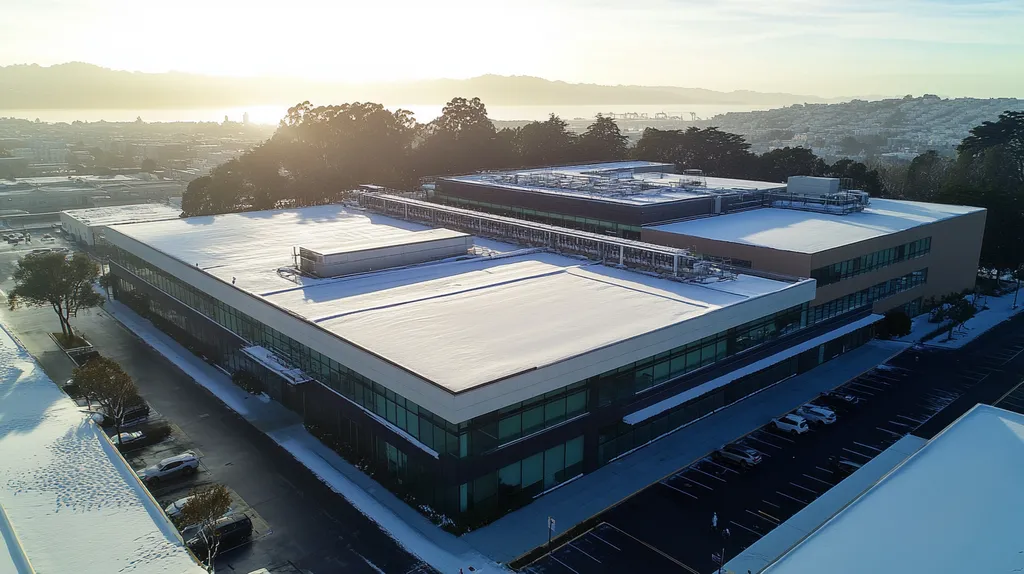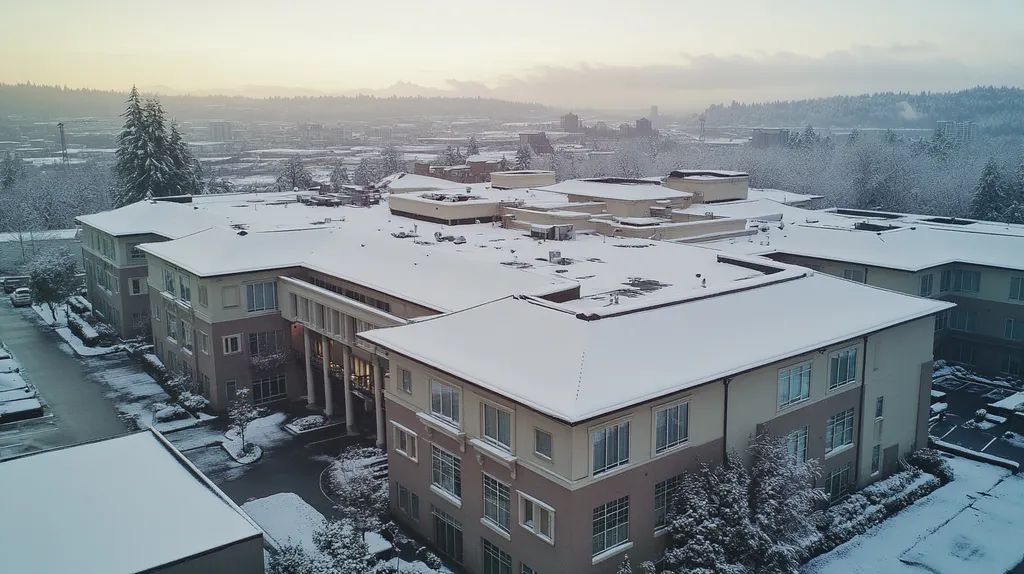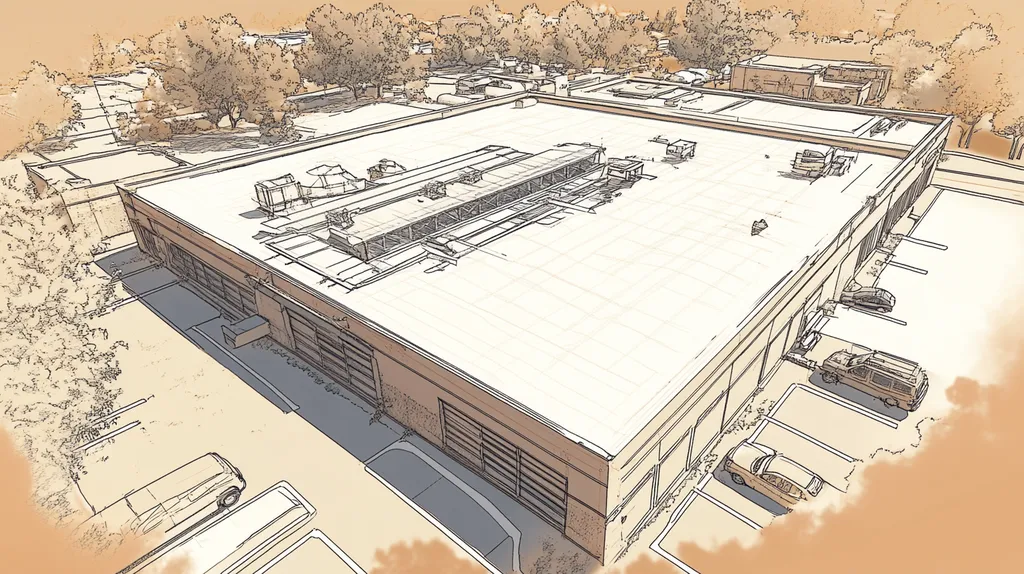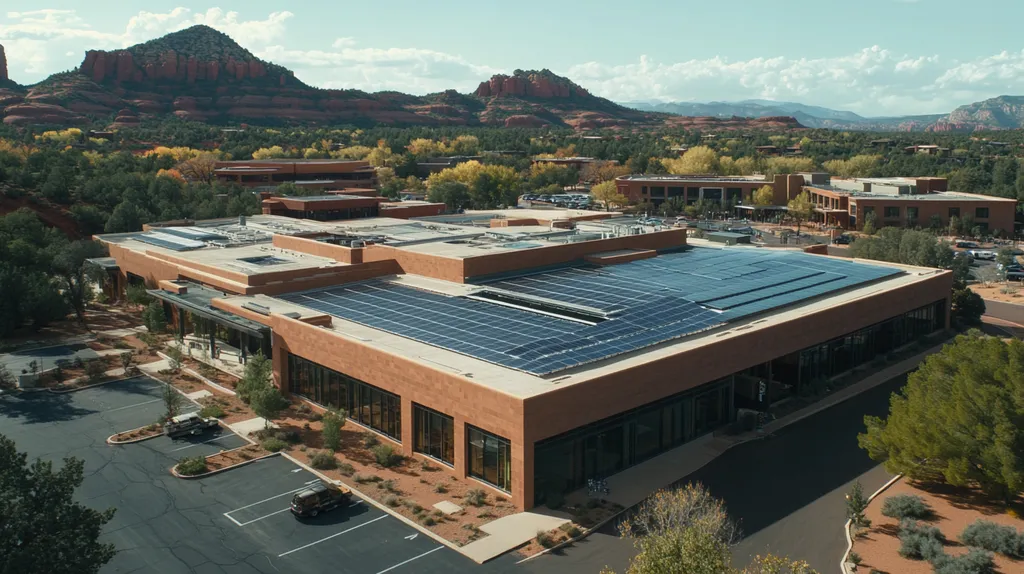Commercial roof coating failures cost U.S. businesses over $2.5 billion annually, with 40% of these failures directly linked to poor coating selection practices.
Despite advances in coating technology, many property owners continue relying on outdated selection methods that overlook critical safety protocols, environmental impacts, and climate-specific requirements.
This analysis examines systemic flaws in current coating selection approaches and presents data-driven solutions for enhancing long-term roof performance while reducing maintenance costs.
SECTION 1: CURRENT PRACTICES
Selecting the right coating for a commercial roof is vital for ensuring longevity and optimal performance. Many property owners base their decisions on incomplete information or common pitfalls. In fact, studies show that almost 30% of roof failures occur due to improper coating selection. Recognizing these deficiencies in current practices can greatly influence the lifespan of roofs and the costs associated with their maintenance.
Licensing and Insurance Oversights
Property owners often assume that all roofing contractors possess the necessary licenses and insurance. Unfortunately, this is not always the reality. Insufficient oversight enables unqualified individuals to offer coating services, jeopardizing both roofs and financial investments.
Without proper licensing, property owners face risks as there is no assurance that contractors meet industry standards. This oversight can lead to subpar workmanship that falters under environmental pressures.
Moreover, if a contractor lacks adequate insurance coverage, property owners could be held liable for any accidents or damages during the project. Such lapses can result in costly repairs later on. For example, a coating incorrectly applied by an unlicensed contractor may necessitate an entire roof replacement sooner than anticipated.
As a result, verifying a contractor’s credentials should be an essential step for property owners. Conducting thorough checks helps avoid significant long-term issues while safeguarding their investment.
Experience and Expertise Evaluation
The roofing industry faces a critical gap in assessing contractor experience effectively. Relying solely on a contractor’s years in business can be misleading. Expertise in applying specific roof coatings might not correlate with general industry tenure.
For example, a company could have decades of experience but little knowledge of modern reflective coatings. This could leave property owners grappling with lackluster results that fail to provide the benefits promised, like improved energy efficiency.
Additionally, an inexperienced contractor may neglect essential preparation or proper application techniques. Such oversights could result in adhesion failures, leading to issues like peeling or blistering, which compromises the coating’s performance.
To mitigate these risks, property owners should prioritize contractors who can provide verified references and relevant case studies. This practice ensures that the chosen service provider possesses the essential knowledge and skills to uphold the roof’s integrity.
Proposal and Warranty Analysis
Roofing proposals often lack clarity, creating confusion for property owners. A quality proposal should transparently outline every aspect of the roofing system, including specific types of coatings to be used. When proposal documents are vague, property owners may not grasp the full extent of what they are funding.
Furthermore, not all warranties are equal. Some warranties offer comprehensive coverage, while others contain loopholes that could leave property owners exposed. Understanding these stipulations is critical, as specific types of coatings may require particular maintenance to remain under warranty.
For instance, a coating might be labeled as “high performance,” yet without a clear warranty detailing its expected lifespan under typical weather conditions, property owners may face uncertainty. This lack of clarity can ultimately lead to unexpected repair costs.
Thus, engaging in a thorough review of proposals and warranties is crucial for property owners. This diligence empowers them to make informed decisions that align with their long-term roofing objectives.
SECTION 2: SYSTEMIC ISSUES
The commercial roofing industry grapples with systemic issues that undermine effective coating selection. Alarmingly, around 40% of roof failures stem from inadequate surface preparation or poor application practices. This statistic underscores the urgent need for a more structured approach to selecting roof coatings. Key factors contributing to these shortcomings include a lack of standardized safety protocols, insufficient manufacturer certification, and inadequate review and reputation checks for both products and contractors. Addressing these challenges is essential for enhancing roof lifespan and performance.
Lack of Standardized Safety Protocols
In commercial roofing, safety often takes a back seat, with many contractors overlooking standardized safety protocols. This negligence can lead to hazardous conditions during roofing projects, jeopardizing the wellbeing of workers and compromising coating quality.
Additionally, variable safety practices can result in violations of OSHA regulations, exposing property managers to potential fines. Adopting standardized safety protocols could significantly reduce risks and ensure that coatings are applied correctly and effectively.
Implementing universal safety guidelines throughout the industry would enhance workplace safety, guaranteeing that all roofing projects meet high safety standards. This proactive approach would improve outcomes for workers and property owners alike.
Integrating safety protocols into the coating selection process is crucial. It establishes a robust framework that not only protects workers but also enhances the overall quality and reliability of roofing installations.
Inadequate Manufacturer Certification
A major concern in the commercial roofing coating market is the lack of rigorous manufacturer certification. Many products are marketed without stringent testing, leading to uncertainty about their performance and durability. This gap raises critical concerns for property owners and facility managers who depend on reliable products.
In the absence of trustworthy certifications, distinguishing quality coatings from substandard options becomes increasingly difficult. Property managers may inadvertently invest in inferior products, resulting in unexpected repair or replacement costs.
The industry urgently needs a standardized certification process that validates the performance, longevity, and safety of roofing materials. Such a framework would empower property owners to make informed choices based on independent data.
Establishing a comprehensive certification system would hold manufacturers accountable. This change would ensure that only high-quality, durable roof coatings reach the market, benefiting the entire commercial roofing sector.
Insufficient Review and Reputation Checks
The lack of thorough review and reputation checks for both roofing products and contractors is another systemic issue that hinders effective coating selection. Property owners often rely on informal recommendations or quick online searches, which may not provide a complete picture of a contractor’s qualifications or the effectiveness of specific coatings.
This tendency can lead to decisions based on incomplete or misleading information, potentially resulting in hiring contractors who lack necessary expertise. Such oversight can compromise the integrity of the roofing installation and the overall performance of the coating.
Comprehensive review systems that evaluate contractor performance and product efficacy are essential. Creating accessible databases where property owners can find verified customer feedback would significantly improve transparency in the industry.
By prioritizing thorough reputation checks, property owners can greatly enhance their chances of selecting reliable products and skilled contractors. This proactive approach contributes to better long-term results and greater satisfaction in commercial roofing projects.
SECTION 3: MISSED OPPORTUNITIES
In the quest for durable and efficient roofs, property owners often overlook critical elements that significantly affect long-term performance. Alarmingly, nearly 30% of commercial roofs fail prematurely due to improper coating selection. Neglecting factors such as environmental impact, long-term cost efficiency, and climate-specific needs can escalate expenses and diminish building functionality. This section will delve into these missed opportunities that could save property owners considerable time and money.
Overlooking Environmental Impact
Environmental considerations are frequently downplayed when choosing roof coatings. Many traditional coatings contain harmful chemicals that can contaminate local ecosystems. According to the Environmental Protection Agency, roof runoff can significantly contribute to urban pollution, highlighting the urgency of selecting safer alternatives.
Opting for eco-friendly coatings not only alleviates environmental concerns but can also provide financial incentives, such as rebates. For example, cool roofing coatings reflect sunlight, helping to lower urban heat and subsequently reduce energy usage. Failing to consider these options can lead to environmental harm and higher long-term costs due to energy waste.
Moreover, companies today are under closer scrutiny for their environmental impact. A coating that lacks sustainability can harm a brand’s reputation. Thus, selecting a coating with a minimal ecological footprint not only meets regulatory demands but also enhances market competitiveness.
Incorporating environmentally responsible choices into roof coating decisions can significantly reinforce a business’s commitment to sustainability, ultimately affecting its bottom line.
Ignoring Long-Term Cost Efficiency
Many property owners mistakenly concentrate solely on initial costs when selecting roof coatings, disregarding the total cost of ownership throughout the roof’s lifespan. Cheaper coatings may seem attractive, but they often necessitate more frequent applications, leading to mounting maintenance costs.
Research indicates that investing in higher-quality coatings generally results in lower overall expenses over time. These coatings can extend a roof’s lifespan and improve energy efficiency, which translates to reduced utility bills. The initial savings from budget coatings can be misleading, as the long-term costs often surpass the upfront price.
Furthermore, prematurely failing cheaper coatings can disrupt business operations and necessitate costly repairs. Unexpected closures may negatively impact profits and client relationships. Therefore, neglecting the long-term economic benefits associated with higher-quality coatings can lead to severe financial repercussions.
Effective planning should assess the cost benefits of higher-quality coatings, ensuring property owners make informed, responsible decisions for long-term financial viability.
Neglecting Climate-Specific Coating Needs
Climate significantly influences the efficacy of roof coatings, yet this factor is often overlooked during selection. Different climatic conditions, whether hot, cold, or humid, necessitate specific coatings to optimize roofing performance. For example, a coating suitable for a tropical climate may fail in a dry desert environment.
Inadequate matching of coatings to climate can lead to issues like accelerated wear or moisture damage. Understanding local weather conditions is crucial for determining the best coating materials and technologies to use.
Some coatings excel in UV reflection, while others provide exceptional insulation. Choosing a coating specifically designed for the local climate enhances energy efficiency and protects the structural integrity of the building. Ignoring these specifics can lead to subpar performance and costly repairs.
Overall, recognizing climate-specific needs when selecting roof coatings not only improves performance but also contributes to the roof’s longevity, reducing the likelihood of premature failures.
SECTION 4: ROOT CAUSES
Choosing the wrong coating for a commercial roof can lead to expensive repairs and decreased property value. It is estimated that over 30% of roof failures stem from poor decision-making regarding coatings. A closer examination of root causes—including inadequate training, poor communication, and inconsistent industry standards—can equip property owners and facility managers with the insights needed to make informed choices.
Inadequate Training and Education
A key challenge in the roofing industry is the lack of thorough training and education for those making roofing decisions. Many property owners depend on anecdotal evidence or brief interactions with vendors, resulting in choices that are often misinformed. Comprehensive training programs that highlight the characteristics and benefits of various roof coatings are frequently neglected.
Without a solid understanding of roofing options, decision-makers may select coatings that fail to meet the specific needs of their buildings. For example, reflective coatings are beneficial in sunny areas for energy savings, while moisture-resistant coatings are essential in humid climates. Effective training can help bridge these knowledge gaps.
Additionally, industry certifications and continuous education should be prioritized. Implementing robust training systems enhances property managers’ decision-making capabilities, thereby reducing the risk of improper coating selections. This informed approach ultimately leads to longer roof life and savings over time.
The absence of sufficient training can have severe and lasting effects on roof performance and the building’s overall integrity. Investing in educational resources not only mitigates risks but also ensures better outcomes for property investments.
Poor Communication and Transparency
Another fundamental issue affecting coating choices is the lack of clear communication among contractors, manufacturers, and property owners. Vendors often do not adequately elucidate the implications of their products, leading to misunderstandings about durability and effectiveness. This lack of transparency can result in critical information being overlooked.
For instance, a contractor may promote a coating without fully addressing its limitations, leaving the property owner unprepared for unexpected failures. Such oversights often result in higher repair costs than initially budgeted. Clear communication about costs, warranties, and required maintenance is essential.
Building consistent channels of communication ensures that all parties are aligned in their objectives and expectations. Regular meetings and written agreements can clarify roles and keep everyone informed. A culture of open dialogue helps streamline decision-making processes and fosters cooperation.
In the long run, improved communication reduces misunderstandings and leads to better collaboration, yielding roofs that meet or exceed performance expectations. Property owners should insist on clear communication throughout the coating selection process.
Inconsistent Industry Standards
The roofing industry is plagued by a lack of consistent standards regarding coatings, resulting in confusion and poor choices. Different manufacturers may offer products with similar names but varying performance levels. This inconsistency complicates the selection process for property owners and facility managers alike.
For example, one coating labeled as “energy-efficient” may perform better in terms of reflectivity than another with the same label, leaving property owners uncertain about their choices. Such disparities can directly impact roof performance and energy savings. Standardizing product terminology and specifications could alleviate much of this confusion.
Additionally, varied installation practices across regions can further muddle decision-making. Following universally accepted standards enhances the reliability of available coatings, simplifying the selection process for property managers.
Establishing consistent industry standards empowers property owners with reliable data for better decision-making, resulting in higher-quality roofs that endure over time. This approach not only benefits individual properties but also strengthens the entire commercial roofing sector.
DATA DRIVEN EVIDENCE
Selecting the wrong roof coating can lead to significant financial setbacks. An analysis indicates that 30% of coatings fail within the first five years, creating unexpected costs and potentially compromising safety and compliance. Utilizing evidence on coating performance is paramount for informed decision-making. This section focuses on statistical analyses of failures, successful case studies, and industry best practices to improve coating selection processes.
Statistical Analysis of Coating Failures
Statistical reviews illuminate troubling patterns in coating failures industry-wide. A survey conducted by the Roofing Contractors Association revealed that nearly 40% of building owners experienced issues like peeling and blistering within the initial years of application. These problems are often linked to improper installation or mismatched products, highlighting the necessity for a well-informed selection process.
The analysis also indicated that specific coatings, such as acrylics, are more prone to failure in extreme climate conditions. In areas facing high temperature fluctuations, selections made without consideration for local environments resulted in early degradation. This data stresses the need to factor environmental conditions into coating decisions.
Understanding these statistics can guide better choices and result in substantial cost savings. By aligning their selections with data-driven insights, property owners can sidestep the dangers of coating failures. This shift from generic to customized solutions is critical.
In summary, the systematic evaluation of coating products is essential for maintaining roof health. By prioritizing statistical data, property owners can safeguard their investments and yield optimal outcomes.
Case Studies on Successful Applications
Case studies shed light on successful coating applications, offering practical lessons for property owners. For instance, a large manufacturing facility in Texas opted for a fluid-applied membrane designed for high UV exposure. This strategic choice led to a remarkable ten-year extension of the roof’s lifespan, underscoring the necessity for tailored approaches.
Another notable example comes from a retail center in Florida that struggled with severe humidity. By selecting a silicone coating, they achieved significant advancements in waterproofing and durability with minimal upkeep. These instances illustrate how a keen understanding of specific building requirements can yield advantageous results.
Effective applications often translate into considerable financial savings. In both cases, operational disruptions were kept to a minimum, resulting in drastically reduced repair costs. This reinforces the need for decisions grounded in real-world evidence.
Ultimately, these case studies indicate that aligning coating choices with building specificities maximizes both performance and durability. Adopting proven strategies enables property owners to make well-informed decisions with long-lasting benefits.
Industry Reports on Best Practices
Recent industry reports emphasize the importance of adhering to established best practices in coating selection. The National Roofing Contractors Association regularly publishes summaries on coating performance, advocating for a transition to evidence-based methodologies.
For instance, one report uncovered that coatings applied by certified contractors encounter 25% fewer failures. This statistic highlights the pivotal role that professional installation plays in conjunction with product selection. Regular inspections and maintenance are also recommended, further contributing to the longevity of coatings.
The reports also acknowledge technological advancements as significant game changers. For example, thermal imaging is increasingly used to detect moisture issues early, allowing for preventative action to be taken. Embracing these technologies can drastically reduce risks associated with potential coating failures.
In conclusion, industry reports collectively call for a reevaluation of traditional approaches to coating selection. Following documented best practices helps property owners enhance the durability and efficacy of their roofing systems.
SECTION 6: ALTERNATIVE SOLUTIONS
With the increasing complexity of demands on commercial roofs, exploring alternative coating solutions is essential. Traditional methods often neglect critical factors such as safety, sustainability, and transparency. As scrutiny intensifies around environmental impacts and labor safety standards, property owners must seek innovative options that effectively address these issues while ensuring long-lasting roof protection.
Implementing Robust Safety Measures
Safety in roofing projects has become a necessity rather than an option. By implementing robust safety measures, property owners can safeguard their workers from the hazards associated with coating applications. Proper use of personal protective equipment (PPE) and comprehensive training programs can significantly enhance safety on job sites.
Additionally, adopting stringent safety protocols can reduce accidents, which in turn minimizes project delays and associated liabilities. Property owners should prioritize contractors who demonstrate a strong commitment to safety, supported by certified training programs and regular safety assessments.
Furthermore, selecting non-toxic materials can mitigate health risks for workers. Opting for low-VOC (volatile organic compound) coatings improves indoor air quality during application, promoting well-being for workers and minimizing environmental impacts.
By fostering a safety-conscious culture within the roofing industry, property owners can contribute to accountability and elevate standards for all stakeholders involved.
Adopting Sustainable Coating Options
Sustainability is paramount in today’s roofing landscape. Traditional coatings can be detrimental to the environment, leading to pollution and excessive waste. Switching to sustainable alternatives, such as reflective or cool roofing coatings, can dramatically lower heat absorption and energy consumption in buildings.
Reflective coatings enhance energy efficiency, leading to decreased utility costs and creating a more comfortable indoor environment that ultimately boosts occupant satisfaction.
Many eco-friendly coatings also come with extended warranties, addressing concerns over durability and lifespan. Property owners should target manufacturers who prioritize sustainability to ensure compliance with modern environmental standards.
Embracing sustainable coating options not only meets regulatory requirements but also reflects a commitment to corporate responsibility, positively impacting both the community and the environment.
Enhancing Transparency in Proposals and Warranties
Transparency in coating proposals is essential for informed decision-making. Property owners often struggle to evaluate the true costs and benefits associated with different roofing coatings. Comprehensive proposals should detail not only pricing but also the scope of work, material specifications, and anticipated lifespan.
Moreover, warranties must clearly define coverage and conditions; vague language can lead to misunderstandings that may result in disputes. By demanding clarity in these agreements, property owners can better protect their investments and avoid unexpected costs.
Contractors should foster transparent communication practices that build trust and accountability. An open dialogue regarding project expectations and potential risks is crucial for achieving successful roofing outcomes.
Ultimately, prioritizing transparency in proposals and warranties cultivates confidence among clients, paving the way for long-lasting partnerships founded on mutual understanding.
The Bottom Line
With over $2.5 billion lost annually to coating failures, the commercial roofing industry cannot afford to maintain outdated selection practices.
Current data shows that 40% of coating failures stem from poor selection processes, highlighting the urgent need for systematic change.
By implementing data-driven protocols, enhancing safety measures, and prioritizing sustainability, property owners can significantly reduce risks while extending roof lifespans.
The transition to transparent, standardized practices must become an immediate priority for the industry.
Only through the adoption of rigorous selection criteria, proper contractor vetting, and climate-specific solutions can commercial properties achieve optimal roof performance and protection of their investments.
FREQUENTLY ASKED QUESTIONS
Q. What are common pitfalls in commercial roof coating selection?
A. Many property owners base their coating selections on incomplete or misleading information. Common pitfalls include not verifying contractor credentials, failing to conduct thorough research on material effectiveness, and neglecting to consider environmental impacts. These oversights can result in increased maintenance costs and reduced roof lifespan.
Q. How do systemic issues affect commercial roof coatings?
A. Systemic issues such as inadequate surface preparation and lack of manufacturer certification contribute significantly to coating failures. These underlying problems often arise from insufficient safety protocols and poor communication between contractors and property owners. Addressing these challenges is essential for selecting effective roofing solutions and improving overall performance.
Q. What missed opportunities lead to early roof coating failures?
A. Property owners often neglect factors such as environmental impact, long-term cost efficiency, and climate-specific needs. Failing to consider these elements can result in higher costs and diminished roof performance. A strategic approach to coating selection can enhance longevity and reduce future repair expenses.
Q. What are the root causes of poor coating decisions for commercial roofs?
A. Root causes include inadequate training of decision-makers and poor communication between contractors and property owners. Many individuals rely on anecdotal evidence rather than comprehensive information about different coatings. Understanding these factors can empower property managers to make better coating choices that enhance roof durability.
Q. How important is data-driven evidence in coating selection?
A. Utilizing data-driven evidence is crucial for selecting reliable roof coatings. Statistical analyses reveal common failure patterns and identify coatings prone to issues in specific climates. Property owners can significantly reduce unexpected costs and enhance performance by making informed decisions based on these insights.
Q. What alternative solutions exist for commercial roof coatings?
A. Alternatives include implementing robust safety measures and adopting sustainable coating options. These practices enhance worker safety and environmental responsibility. Additionally, focusing on transparency in proposals and warranties can ensure better decision-making, ultimately contributing to more effective and durable roofing solutions.
Q. How can I assess a contractor’s qualifications for my industrial roof?
A. Assessing a contractor’s qualifications involves checking their licensing, insurance, and relevant experience. Request verified references and case studies that showcase their expertise with specific roof coatings. This diligence ensures that you select a competent contractor capable of meeting your specific coating needs and maintaining the roof’s integrity.










